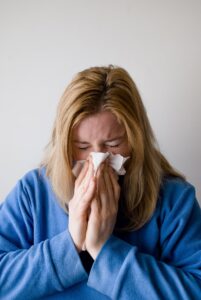Illness etiquette
Hattie Haller, 36, a mom from Louisville, Ky., is a self-proclaimed germaphobe. She doesn’t leave home without her endless supply of hand sanitizer and antibacterial wipes, and she has plenty of pet peeves when it comes to other people bucking proper cold etiquette.
“It really bugs me when people cough without covering their mouth,” she says, launching into a story of a plane trip she took when she was about six months pregnant with her daughter. The woman next to her clearly had a contagious cold, and she coughed, sneezed, and wiped her nose with her hand the whole plane ride. Haller finally gave up her aisle seat to squish into a cramped — but less germy — middle seat.
Haller certainly follows cold etiquette herself and started teaching her daughter how to contain her germs by the time she was about 18 months old. She taught her to properly cover her mouth when she coughed and to keep her hands off of her face to keep germs away.
Refer this link for live stats in COVID 19
5 Etiquette Tips to Follow
The fact is that cold etiquette is more than simple good manners; it’s a matter of good health, for you and your community. Here are five etiquette tips to follow when you’re coughing, sneezing, and showing other signs of a contagious cold:
Sneeze into your elbow, not your hand.
- As kids, most people were taught to cover their nose and mouth with their hands when they sneeze. But then where does that leave your germs? All over your hands, of course. The U.S. Centers for Disease Control and Prevention has been campaigning to get kids (and adults too) to learn to sneeze into their elbows instead. “You can’t get to a sink immediately,” says Kathryn Teng, MD, a physician in the department of internal medicine and director of clinical integration of personalized health care at the Cleveland Clinic in Ohio. “And you touch so many things. It’s really a great way to contain germs.”

Wash or sanitize hands frequently.
- When it comes to washing your hands, “you really just can’t do it enough in the wintertime,” says Dr. Teng. Of course, you can get viruses, colds, and the flu any time of year. But “it’s more rampant in the wintertime because we’re inside and in closer quarters.” So head to the sink, soap up, and scrub up after you sneeze, before you eat, and any other chance you get.

Warn others that you’re just getting over the flu.
- Haller’s son was born during cold and flu season. She had a houseguest show up, planning to smooch all over that new baby, knowing full well that she was sick. It’s just good manners and common courtesy, she says, to let someone know that you’re sick before you show up to find out if it’s still okay to come over.

Stay home if you’re not feeling well.
- If you have a fever or are just overall feeling sick, it’s best to stay home, says Teng. That way you’re not putting so many others at risk. And at work or school, those confined spaces are perfect for trapping germs and spreading them all around. Your boss and your child’s teacher will thank you for your consideration and your help in preventing the spread of your illness to the whole group.

Excuse yourself from shaking hands if you’re sick.
- What’s worse than seeing a sniffling, sneezing person extending her hand for you to shake? You don’t want to be rude and ignore her, but it’s not exactly polite to offer a germy hand in the first place. “I think it’s rude when people know that they’re sick and they go ahead and shake people’s hands,” says Haller. “Don’t cough or blow your nose and then hold out your hand for me to shake.” Instead, simply politely excuse yourself by saying something like, “Excuse me for not shaking your hand, but I’ve been sick.” Your friends and colleagues will appreciate the gesture — and not sharing your germs.

For more tips refer to this link
- Manners take on a whole new meaning when their intent is to protect your health and the health of those around you. Follow these tips on cold etiquette and rest assured there won’t be whispering behind your back — or glares from those afraid of catching your germs.
To polish your knowledge about THE CLINICAL CARE OF THE DIABETIC FOOT refer this link
